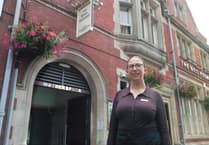A CAMPAIGN to save a south Herefordshire village’s old Victorian school from demolition has been granted leave to take the case to the Court of Appeal.
Residents in Garway have been battling for three years to try and save the rundown Old School from the bulldozers, after its farmer owner was given the go ahead to pull it down by Herefordshire Council.
Planners said they had no legal power to stop the demolition, despite having granted Gerard Davies planning permission to convert the 146-year-old building into two homes in 2013.
The Wonastow farmer says he now intends to replace the building with hard-standing, but residents fear the site will ultimately be used for new housing.
The campaign to save it has been supported by the SAVE Britain’s Heritage group, who pursued a judicial review of the council decision, which was rejected at the Royal Courts of Justice in London in November.
They then applied for leave to appeal, which was granted last week, with a hearing expected to take place this spring.
SBH director Henrietta Billings says: “We are delighted the Court of Appeal has granted us permission to proceed with the appeal. This case raises important issues around the rights of owners to demolish buildings without full planning permission.
“The Court of Appeal has an opportunity to provide clarity on the threshold of uninhabitable buildings under the current regulations, and could therefore have far-reaching consequences for the future of thousands of unprotected historic buildings.”
SBH will be making the case that demolition was approved without correct process under “a planning loophole” called Permitted Development Rights).
At the November hearing, SBH argued that the council had failed to properly assess whether the school was unsafe or uninhabitable, a key test when deciding whether to permit applications under PDR.
For the demolition of a building under PDR – which bypasses the need for full planning permission – a building must not have been rendered unsafe or uninhabitable as a result of the owner’s own neglect.
SBH claim that the council did not apply the correct test when considering whether PDR applied to Garway School.
Group conservation officer Ben Dewfield-Oakley described the appeal as “the last chance to save this important and locally loved building”.
“As with all of SAVE’s work, the ultimate aim of our campaign is to see this historic building sustainably reused and Garway’s history and character preserved, while also providing attractive and much-needed new housing,” he added.
The long-running saga initially saw the council refuse the owner’s first application to demolish the buildings in 2021 owing to lack of information. The council also made a detailed application to Historic England for the building to be granted protection by heritage listing.
But while emphasising its “historic interest as an early board school in a remote countryside location, and local interest for the connection of its architect EH Lingen Barker”, the heritage watchdog declined to list it because it wasn’t of national importance.
Mr Davies bought the building in 1981 after the school closed, and it was later used as storage space for agricultural and commercial workshops on the site, while the adjoining school house was lived in until 1997.
Last year, villagers protestedoutside the school – one of the community’s few historic buildings, alongside the Knight’s Templar church and local pub.
More than 100 objections were lodged against the successful planning bid to bulldoze the Victorian sandstone building.Residents said a “concrete field” opposite the community centre would be an “eyesore”, while there was no indication about long-term plans for the site.
The Garway Community Centre group also weighed in, calling it an “irreplaceable feature”.
Mr Dewfield-Oakley said previously: “We object to the principle of demolishing these Victorian school buildings on heritage and environmental grounds.”





Comments
This article has no comments yet. Be the first to leave a comment.